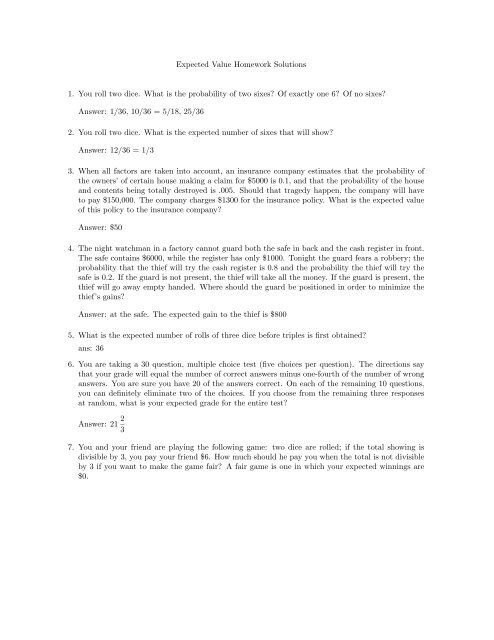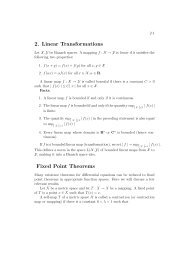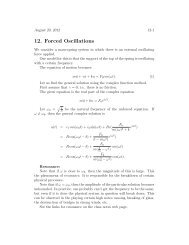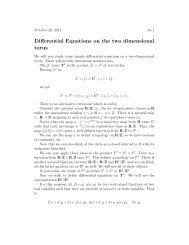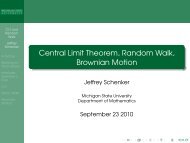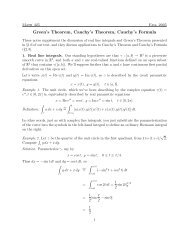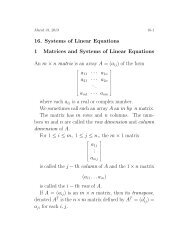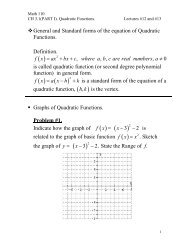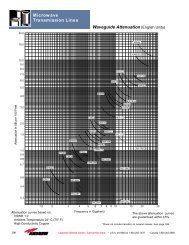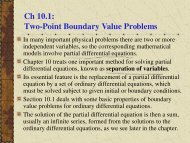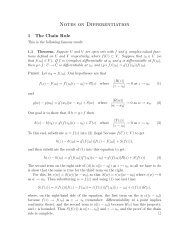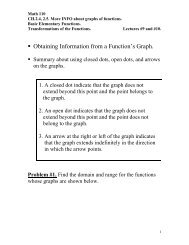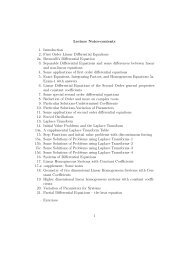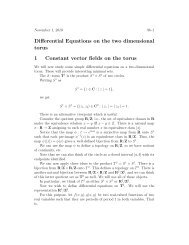Expected Value Homework Solutions 1. You roll two dice. What is ...
Expected Value Homework Solutions 1. You roll two dice. What is ...
Expected Value Homework Solutions 1. You roll two dice. What is ...
You also want an ePaper? Increase the reach of your titles
YUMPU automatically turns print PDFs into web optimized ePapers that Google loves.
<strong>Expected</strong> <strong>Value</strong> <strong>Homework</strong> <strong>Solutions</strong><strong>1.</strong> <strong>You</strong> <strong>roll</strong> <strong>two</strong> <strong>dice</strong>. <strong>What</strong> <strong>is</strong> the probability of <strong>two</strong> sixes? Of exactly one 6? Of no sixes?Answer: 1/36, 10/36 = 5/18, 25/362. <strong>You</strong> <strong>roll</strong> <strong>two</strong> <strong>dice</strong>. <strong>What</strong> <strong>is</strong> the expected number of sixes that will show?Answer: 12/36 = 1/33. When all factors are taken into account, an insurance company estimates that the probability ofthe owners’ of certain house making a claim for $5000 <strong>is</strong> 0.1, and that the probability of the houseand contents being totally destroyed <strong>is</strong> .005. Should that tragedy happen, the company will haveto pay $150,000. The company charges $1300 for the insurance policy. <strong>What</strong> <strong>is</strong> the expected valueof th<strong>is</strong> policy to the insurance company?Answer: $504. The night watchman in a factory cannot guard both the safe in back and the cash reg<strong>is</strong>ter in front.The safe contains $6000, while the reg<strong>is</strong>ter has only $1000. Tonight the guard fears a robbery; theprobability that the thief will try the cash reg<strong>is</strong>ter <strong>is</strong> 0.8 and the probability the thief will try thesafe <strong>is</strong> 0.2. If the guard <strong>is</strong> not present, the thief will take all the money. If the guard <strong>is</strong> present, thethief will go away empty handed. Where should the guard be positioned in order to minimize thethief’s gains?Answer: at the safe. The expected gain to the thief <strong>is</strong> $8005. <strong>What</strong> <strong>is</strong> the expected number of <strong>roll</strong>s of three <strong>dice</strong> before triples <strong>is</strong> first obtained?ans: 366. <strong>You</strong> are taking a 30 question, multiple choice test (five choices per question). The directions saythat your grade will equal the number of correct answers minus one-fourth of the number of wronganswers. <strong>You</strong> are sure you have 20 of the answers correct. On each of the remaining 10 questions,you can definitely eliminate <strong>two</strong> of the choices. If you choose from the remaining three responsesat random, what <strong>is</strong> your expected grade for the entire test?Answer: 21 2 37. <strong>You</strong> and your friend are playing the following game: <strong>two</strong> <strong>dice</strong> are <strong>roll</strong>ed; if the total showing <strong>is</strong>div<strong>is</strong>ible by 3, you pay your friend $6. How much should he pay you when the total <strong>is</strong> not div<strong>is</strong>ibleby 3 if you want to make the game fair? A fair game <strong>is</strong> one in which your expected winnings are$0.
Answer: The probability that the sum <strong>is</strong> div<strong>is</strong>ible by 3 <strong>is</strong> 1/2 and the probability that the sum <strong>is</strong>not div<strong>is</strong>ible by 3 <strong>is</strong> 2/3. <strong>You</strong> can see th<strong>is</strong> by simply writing down all the possibilities. If x <strong>is</strong> theamount you should be paid, thenSolve for x and get x = $3(1/3) × (−6) + (2/3) × x = 08. A friend offers to play you a game where you pay him $1 if the <strong>roll</strong> of a 6-sided die comes up as 1,2, 3, or 4, and he pays you $2 if the die comes up a 5 or 6. <strong>What</strong> <strong>is</strong> the expected value of a round(for you) if you play the game? <strong>What</strong> are the odds of your winning?Answer: The probability that you pay $1 <strong>is</strong> 4/6 since he has 4 ways to win, and the probabilitythat he pays you $2 <strong>is</strong> 2/6. In symbols, th<strong>is</strong> <strong>is</strong>P (−1) = 4/6P (2) = 2/6 so thatE = −1 × (4/6) + 2 × (2/6) = 0.The odds in th<strong>is</strong> case are 2: 1 in your friend’s favor. That the expected value <strong>is</strong> 0 prec<strong>is</strong>ely whenthe payoffs are equal to the odds <strong>is</strong> a general rule. That <strong>is</strong>, if the odds of winning a game area: b, then a fair game, means that the first player’s payoff for winning should be b and the secondplayer’s payoff should be a to make the game fair.9. On flying to and from Denver from Lansing airport, I have calculated the following probabilities(roughly). The probability that I get to Denver on time <strong>is</strong> 2/3, the probability that I get to Denver1 hour late <strong>is</strong> 1/6, the probability that I get to Denver 2 hours late <strong>is</strong> 1/12, and the probabilitythat I get to Denver 3 hours late <strong>is</strong> 1/12. <strong>What</strong> <strong>is</strong> my expected value of lateness?Answer: The problem tells us that we have the following probabilities:Thus the expected value <strong>is</strong>:P (0) = 2/3P (1) = 1/6P (2) = 1/12, andP (3) = 1/12.E = (0 × 2/3) + (1 × 1/6) + (2 × 1/12) + (3 × 1/12) = 7/12.Thus my expected value of lateness <strong>is</strong> 7/12 of an hour, or about 35 minutes.10. My friend and I play the following game: I pay him $2 to play. I flip a coin at most 5 times. If itcomes up heads the first time, I get a $1 and the game ends, otherw<strong>is</strong>e, I flip again and if it comesup heads th<strong>is</strong> time, I get $2. We continue in th<strong>is</strong> way, so that if the first heads <strong>is</strong> on the third tossI get $4, the fourth toss, $8, and the fifth toss $16. <strong>What</strong> <strong>is</strong> my expected value for th<strong>is</strong> game?
Answer: We have the following table for probabilities of when the first heads appears.P (0) = 1/32 The probability that no heads appearP (1) = 1/2P (2) = 1/4P (3) = 1/8P (4) = 1/16P (5) = 1/32.Thus the expected value of what he pays me back <strong>is</strong>0×P (0)+1×P (1)+2×P (2)+4×P (3)+8×P (4)+16×P (5) = 0+1/2+1/2+1/2+1/2+1/2 = 2.5.Thus my expected value <strong>is</strong> $(2.5-2), or 50 cents.1<strong>1.</strong> In the game of birdcage, you pay $1 to play the game. If one of the three <strong>dice</strong> comes up 6, you get$2 back (earning $1). If <strong>two</strong> <strong>dice</strong> come up 6, you get $3 back, and if all three <strong>dice</strong> come up 6, youget $4 back. <strong>What</strong> <strong>is</strong> the expected value of the game?Answer: The probability of no sixes coming up <strong>is</strong> 125216, and in th<strong>is</strong> case you lose $<strong>1.</strong> We next needthe probability of exactly one 6 coming up. Th<strong>is</strong> can happen in one of three ways: the six can beon the first die, the second die, or the third die. For exactly one six, with it on the first die, thereare 1 × 5 × 5 = 25 ways for th<strong>is</strong> to happen. Similarly, there are 25 ways for the six to appear onthe second die, and 25 ways for it to appear on the third die (and for exactly one 6). Thus thereare 75 ways for exactly one six to appear. The value of th<strong>is</strong> outcome <strong>is</strong> $<strong>1.</strong> For exactly <strong>two</strong> sixes toappear, there are 5 ways for the first <strong>two</strong> <strong>dice</strong> to be sixes, 5 ways for the first and the third <strong>dice</strong> tobe sixes, and 5 ways for the last <strong>two</strong> <strong>dice</strong> to be sixes. Consequently there are 15 ways for <strong>two</strong> <strong>dice</strong>to come up six. The value of th<strong>is</strong> outcome <strong>is</strong> $2. Finally, there <strong>is</strong> exactly one way for three sixes tocome up, with a value of $3. Thus the expected value (for you) <strong>is</strong>125 75 15(−1) + (1) +216 216 216 (2) + 1 −17(3) =216 216 .Hence, for every game you play, you expect to lose 7.8 cents.12. The game “Who Wants to be a Millionaire” has $100, $200, $500, $1000, $2000, $4000, $8000,$16000, $32000, $64000, $125000, $250000, $500000, and $1000000 questions. <strong>You</strong> start at the $100levels and work your way up through the questions if you continue to get right answers. Supposeyou got to keep the amount of money of your last correct question (which <strong>is</strong>n’t what happens inthe show). Each question <strong>is</strong> multiple choice with 4 possible answers, only one of which <strong>is</strong> correct.<strong>What</strong> <strong>is</strong> the expected amount of money that a contestant would get if they guess randomly on eachquestion?Answer: We have the following probabilities for money amounts
Thus the expected value <strong>is</strong>:Money P robability Money P robability0 3/4 100 (1/4) × (3/4)200 (3/4) × (1/4) 2 500 (3/4) × (1/4) 31000 (3/4) × (1/4) 4 2000 (3/4) × (1/4) 54000 (3/4) × (1/4) 6 8000 (3/4) × (1/4) 716000 (3/4) × (1/4) 8 32000 (3/4) × (1/4) 964000 (3/4) × (1/4) 10 125000 (3/4) × (1/4) 11250000 (3/4) × (1/4) 12 500000 (3/4) × (1/4) 131000000 (1/4) 14100×(1/4)×(3/4)+200×(1/4)×(3/4) 2 +· · ·+500000×(3/4)×(1/4) 13 +1000000×(1/4) 14 = 39.8408<strong>1.</strong>So about $39.84.13. The prince has searched all over h<strong>is</strong> kingdom for the maiden who left her glass slipper at the ball.He finally arrives at the estate where Cinderella and her <strong>two</strong> evil step-s<strong>is</strong>ters live. The slipperonly fits Cinderella. The prince tries the slipper on the three maidens in random order. <strong>What</strong> <strong>is</strong>the expected number of maidens on whom the prince must try the slipper until he finally findsCinderella?Solution:Let E 1 be the event that the first maiden <strong>is</strong> Cinderella.Let E 2 be the event that the second maiden <strong>is</strong> Cinderella.Let E 3 be the event that the third maiden <strong>is</strong> Cinderella.p(E 1 ) = 1 3 and v(E 1) = 1p(E 2 ) = 1 3 and v(E 2) = 2p(E 3 ) = 1 3 and v(E 3) = 3Substitute these values intoE.V. = p(E 1 ) × v(E 1 ) + p(E 2 ) × v(E 2 ) + p(E 3 ) × v(E 3 ) = 1 + 2 + 33= 214. <strong>You</strong> start with a full deck of cards, which have been shuffled. <strong>You</strong> draw cards from the deck, withoutreplacement, until you get a card other than an ace. <strong>What</strong> <strong>is</strong> the expected value of the number ofcards drawn?Solution:
Let E 1 be the event that the first card <strong>is</strong> not an ace.Let E 2 be the event that the first card <strong>is</strong> an ace and the second card <strong>is</strong> not an ace.Let E 3 be the event that the first <strong>two</strong> cards are aces and the third card <strong>is</strong> not an ace.Let E 4 be the event that the first three cards are aces and the fourth card <strong>is</strong> not an ace.Let E 5 be the event that the first cards are aces and hence the fifth card <strong>is</strong> not an ace.p(E 1 ) = 4852 and v(E 1) = 1p(E 2 ) = 4 × 4852 × 51 and v(E 2) = 2p(E 3 ) = 4 × 3 × 4852 × 51 × 50 and v(E 3) = 3p(E 4 ) = 4 × 3 × 2 × 4852 × 51 × 50 × 49 and v(E 1) = 4p(E 5 ) = 4 × 3 × 2 × 1 × 4852 × 51 × 50 × 49 × 48 and v(E 5) = 1Substitute these values intoE.V. = p(E 1 ) × v(E 1 ) + p(E 2 ) × v(E 2 ) + p(E 3 ) × v(E 3 ) + p(E 4 ) × v(E 4 ) + p(E 5 ) × v(E 5 ) ≈ <strong>1.</strong>0816315. <strong>What</strong> <strong>is</strong> the expected number of face cards (jack, queen, or king) in a three card hand drawn atrandom from a standard deck of cards?Solution:Let E 1 be the event that there are no face cardsLet E 2 be the event that there <strong>is</strong> exactly one face card.Let E 3 be the event that there are exactly <strong>two</strong> face cards.Let E 4 be the event that all three cards are face cards.p(E 1 ) = 40 C 352C 3and v(E 1 ) = 0p(E 2 ) = 12 × 40C 252C 3and v(E 2 ) = 1p(E 3 ) = 12 C 2 × 4052C 3and v(E 3 ) = 2p(E 4 ) = 12 C 352C 3and v(E 1 ) = 3
Substitute these values intoE.V. = p(E 1 ) × v(E 1 ) + p(E 2 ) × v(E 2 ) + p(E 3 ) × v(E 3 ) + p(E 4 ) × v(E 4 ) ≈ 0.6923


